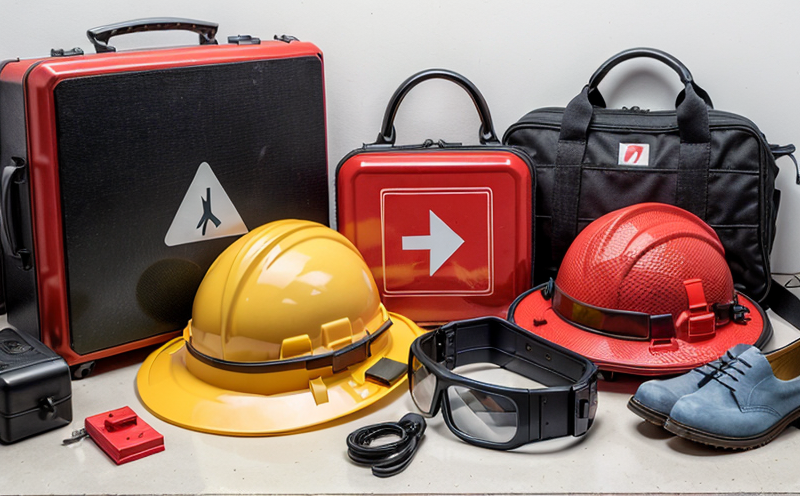EN 402 Emergency Escape Breathing Device Airflow Measurement
The European Standard EN 402 specifies the requirements and test methods for emergency escape breathing devices (EEBDs) used in various occupational safety scenarios. These devices are critical tools designed to provide essential respiratory protection during emergencies, ensuring worker safety in environments where oxygen levels may be compromised or toxic substances present.
Testing EEBDs according to EN 402 involves a series of stringent procedures aimed at evaluating the airflow characteristics of these devices. The standard focuses on the breathing resistance and the minimum flow rates that must be maintained during inhalation and exhalation. This ensures that the device provides adequate protection while also being comfortable for prolonged use.
The testing process typically includes several steps, such as setting up the EEBD in a controlled environment, connecting it to appropriate equipment, and conducting tests under both static and dynamic conditions. Static tests are used to measure resistance without actual breathing, whereas dynamic tests simulate real-world usage by measuring airflow during inhalation and exhalation.
The importance of accurate airflow measurement cannot be overstated. It directly impacts the performance and reliability of the device in critical situations. A poorly designed or malfunctioning EEBD could lead to significant health risks for workers. Therefore, compliance with EN 402 is not just a regulatory requirement but also a crucial aspect of ensuring worker safety.
Compliance with this standard involves detailed documentation of test procedures and results. Reporting should include data on resistance levels, flow rates, and any other relevant parameters as specified in the standard. This documentation serves as evidence that the EEBDs meet the required specifications and are suitable for their intended use.
The testing process also includes regular calibration and validation to ensure consistency over time. This helps maintain the accuracy of measurements and ensures that the devices continue to perform reliably under various conditions. Regular testing is essential, especially in high-risk industries where worker safety is paramount.
In summary, EN 402 provides a robust framework for ensuring the quality and reliability of EEBDs through comprehensive airflow measurement tests. By adhering to this standard, organizations can demonstrate their commitment to occupational safety and compliance with international best practices.
Industry Applications
- Mining: Ensuring workers have reliable respiratory protection in oxygen-deficient atmospheres.
- Firefighting: Providing firefighters with adequate breathing equipment during emergencies.
- Hazardous waste management: Protecting personnel handling toxic substances.
- Petrochemical plants: Offering safety in environments where toxic gases are present.
| Industry | Specific Use Case |
|---|---|
| Mining | Protecting miners from oxygen-deficient atmospheres and toxic fumes. |
| Hazardous waste management | Providing personnel with respiratory protection against hazardous substances. |
| Petrochemical plants | Safeguarding workers exposed to hydrocarbon leaks or other toxic gases. |
The applications of EN 402 are broad and varied, extending beyond just the industries mentioned. The standard is applicable wherever there is a need for reliable respiratory protection during emergencies. This includes construction sites, chemical manufacturing facilities, and any location where workers may be exposed to hazardous conditions.
Eurolab Advantages
At Eurolab, we bring together expertise in occupational safety and testing with state-of-the-art facilities to deliver comprehensive EN 402 compliance services. Our team of professionals ensures that every test conducted is accurate, reliable, and meets the highest international standards.
We provide a range of services including:
- Comprehensive testing according to EN 402
- Calibration and validation of EEBDs
- Detailed reporting and documentation
- Ongoing support for regulatory compliance
Our advanced laboratories are equipped with the latest instrumentation, enabling us to conduct precise and repeatable tests. This ensures that our clients can trust the results we provide.
We understand the importance of timely delivery and strive to meet all project deadlines without compromising on quality. Our commitment to excellence is reflected in our consistent performance and positive client feedback.
International Acceptance and Recognition
The European Standard EN 402 for Emergency Escape Breathing Devices has gained widespread recognition and acceptance across the globe. It is acknowledged as a robust framework for ensuring the quality and reliability of EEBDs, which are critical in various occupational safety scenarios.
Many countries have adopted or referenced this standard within their own regulations, recognizing its importance in protecting workers. The adoption of EN 402 underscores its relevance and effectiveness in promoting worker safety and compliance with international best practices.
The standard is widely accepted by regulatory bodies, manufacturers, and end-users alike. Its comprehensive approach to testing ensures that EEBDs meet strict performance criteria, providing peace of mind for those responsible for occupational safety.





